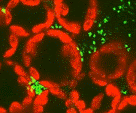Plant Pathology, Department of

Department of Plant Pathology: Faculty Publications
ORCID IDs
0000-0001-8802-4872
Document Type
Article
Date of this Version
2018
Citation
Plant Methods (2017) 13:59
Abstract
Background: Virus-induced gene silencing (VIGS) has been used in many plant species as an attractive post transcriptional gene silencing (PTGS) method for studying gene function either individually or at large-scale in a high-throughput manner. However, the specificity and efficiency for knocking down members of a highly homologous gene family have remained to date a significant challenge in VIGS due to silencing of off-targets. Results: Here we present an improved method for the selection and evaluation of gene fragments used for VIGS to specifically and efficiently knock down members of a highly homologous gene family. Using this method, we knocked down twelve and four members, respectively of group III of the gene family encoding ubiquitin-conjugating enzymes (E2) in Nicotiana benthamiana. Assays using these VIGS-treated plants revealed that the group III E2s are essential for plant development, plant immunity-associated reactive oxygen species (ROS) production, expression of the gene NbRbohB that is required for ROS production, and suppression of immunity-associated programmed cell death (PCD) by AvrPtoB, an effector protein of the bacterial pathogen Pseudomons syringae. Moreover, functional redundancy for plant development and ROS production was found to exist among members of group III E2s. Conclusions: We have found that employment of a gene fragment as short as approximately 70 base pairs (bp) that contains at least three mismatched nucleotides to other genes within any 21-bp sequences prevents silencing of off-target(s) in VIGS. This improved approach in the selection and evaluation of gene fragments allows for specific and efficient knocking down of highly homologous members of a gene family. Using this approach, we implicated N. benthamiana group III E2s in plant development, immunity-associated ROS production, and suppression of multiple immunity-associated PCD by AvrPtoB. We also unraveled functional redundancy among group III members in their requirement for plant development and plant immunity-associated ROS production.


Comments
© The Author(s) 2017.
DOI 10.1186/s13007-017-0210-6